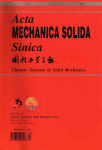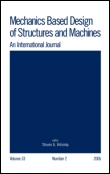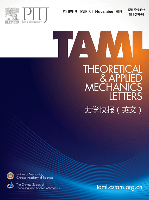
SHOCK AND VIBRATION
Scope & Guideline
Advancing knowledge in shock and vibration phenomena.
Introduction
Aims and Scopes
- Shock and Vibration Analysis:
The journal emphasizes the study of shock and vibration response in different materials and structures, including the development of theoretical models and experimental techniques. - Fault Diagnosis and Condition Monitoring:
A core focus is on methodologies for diagnosing faults in mechanical systems, particularly in rotating machinery and bearings, utilizing advanced signal processing techniques. - Seismic Response and Engineering Applications:
Research on the seismic response of structures, including bridges and buildings, is a significant area, contributing to the development of better engineering practices for earthquake resilience. - Material Behavior Under Dynamic Loading:
Studies investigating the mechanical properties of materials under dynamic and impact loading conditions, particularly in mining and construction contexts, are frequently published. - Numerical and Experimental Methods:
The journal showcases both numerical simulations and experimental investigations, promoting the integration of computational and empirical approaches to the study of shock and vibration.
Trending and Emerging
- Machine Learning and AI Applications:
There is a significant increase in research utilizing machine learning and AI techniques for fault diagnosis and predictive maintenance in mechanical systems. - Smart Materials and Adaptive Systems:
Emerging trends focus on the use of smart materials and adaptive vibration control systems that can respond dynamically to changing load conditions. - Microseismic Monitoring and Analysis:
Research involving microseismic monitoring techniques for real-time analysis of geological and structural responses is gaining traction, particularly in mining and civil engineering. - Environmental Impact and Sustainability:
Increasing attention is being paid to the environmental impacts of vibration and shock, with studies focusing on sustainable practices in engineering and construction. - Hybrid and Multiscale Modeling Approaches:
The integration of hybrid modeling approaches that combine various scales and methods (e.g., continuum and discrete methods) for analyzing complex systems is becoming more prevalent.
Declining or Waning
- Traditional Vibration Control Techniques:
Interest in conventional vibration control methods is declining, as researchers increasingly explore advanced materials and smart systems for vibration mitigation. - Static Analysis of Structures:
There is a noticeable reduction in publications focused solely on static analysis, as more studies emphasize dynamic behavior and real-time analysis under varying conditions. - Basic Shock Analysis without Contextual Application:
Papers that discuss basic shock analysis principles without application to real-world problems or integration into larger systems are becoming less common.
Similar Journals

ACTA MECHANICA SOLIDA SINICA
Advancing the Frontiers of Solid MechanicsACTA MECHANICA SOLIDA SINICA is a prestigious journal published by Springer, dedicated to advancing research in the fields of Computational Mechanics, Mechanical Engineering, and Mechanics of Materials. Since its inception in 1981, the journal has established a significant presence in the academic community, holding a commendable Q2 ranking across its categories as of 2023. Furthermore, it is recognized for its impactful contributions, with Scopus rankings placing it in the top quartiles, fostering essential discourse among professionals and researchers in the engineering domain. While it operates under a traditional access model, ACTA MECHANICA SOLIDA SINICA continues to provide valuable insights and developments, making it an essential resource for those seeking to deepen their understanding of solid mechanics and related disciplines. The journal remains an influential platform for innovative theoretical and experimental studies, reinforcing its status in the global academic landscape.

Mechanical Sciences
Exploring the intersections of mechanics and multidisciplinary applications.Mechanical Sciences is a prominent open-access journal published by COPERNICUS GESELLSCHAFT MBH since 2010, dedicated to advancing the field of mechanical engineering and its multidisciplinary applications. Operating from Göttingen, Germany, the journal has established a vital platform for researchers and professionals alike, facilitating the sharing of original research, reviews, and innovative methodologies across various domains, including civil and structural engineering, control and systems engineering, fluid flow, industrial engineering, and mechanics of materials. With a current impact factor placing it in the Q3 category across several engineering disciplines, Mechanical Sciences provides a valuable resource that not only highlights emerging trends but also contributes to the ongoing discourse within the engineering community. The journal's commitment to open access ensures that its content is widely accessible, encouraging collaboration and knowledge sharing among students, educators, and industry experts worldwide. As it continues to converge towards 2024, Mechanical Sciences remains an essential reference for anyone invested in the mechanics of engineering and related fields.

Journal of Theoretical and Applied Mechanics
Innovating Solutions in Theoretical and Applied MechanicsJournal of Theoretical and Applied Mechanics, published by the Polish Society of Theoretical and Applied Mechanics, stands as a leading platform for disseminating cutting-edge research in the realms of theoretical and applied mechanics. With its ISSN 1429-2955 and E-ISSN 1429-2955, this Open Access journal has been fostering academic dialogue since 2006, making knowledge readily accessible to researchers and practitioners alike. Based in Warsaw, Poland, the journal encompasses a wide breadth of topics within mechanics, appealing to a diverse readership including researchers, professionals, and students. The journal's current Scopus ranking places it within the 30th percentile of the field, emphasizing its relevance and contribution to the discipline. As it converges from 2007 to 2024, the Journal of Theoretical and Applied Mechanics is pivotal for those seeking to advance understanding and innovation in mechanical engineering and mathematics, making it an essential resource for anyone involved in these critical areas of study.

MECHANICS RESEARCH COMMUNICATIONS
Advancing the Frontiers of Mechanics and MaterialsMECHANICS RESEARCH COMMUNICATIONS, published by PERGAMON-ELSEVIER SCIENCE LTD, is a prestigious journal in the fields of Civil and Structural Engineering, Condensed Matter Physics, Materials Science, and Mechanical Engineering. With an ISSN of 0093-6413 and E-ISSN of 1873-3972, it has made significant contributions to the understanding and advancement of mechanics and materials since its inception in 1974. The journal is well-regarded in academia, holding a Q2 ranking across multiple categories as of 2023, and ranking in the 65th percentile for Mechanical Engineering. Researchers and professionals benefit from its peer-reviewed content, which includes a wide range of articles from fundamental research to applied technological developments. Although currently not an open access journal, it remains a vital resource for those focused on innovating within the engineering and materials science domains. With its established legacy, MECHANICS RESEARCH COMMUNICATIONS continues to shape the discourse in mechanics and engineering, making it essential reading for students and practitioners alike.

ARCHIVES OF MECHANICS
Connecting Researchers Through Open Access KnowledgeArchives of Mechanics, published by the Polish Academy of Sciences Institute of Fundamental Technological Research, is a distinguished open-access journal established in 1971 that has played a pivotal role in the dissemination of knowledge in the fields of Mechanical Engineering and Condensed Matter Physics. With its commitment to accessibility since adopting open access in 2022, this journal provides a platform for researchers, professionals, and students to share cutting-edge research findings and innovative methodologies. Although it currently holds a Q4 ranking in Condensed Matter Physics and a Q3 ranking in Mechanical Engineering for 2023, its comprehensive scope, which spans critical advancements in mechanical systems and materials science, positions it as a valuable resource for the academic community. Located in Warsaw, Poland, the journal continues to contribute significantly to the global discourse on mechanics and is dedicated to fostering new ideas that advance both theoretical and applied aspects of the discipline.

CANADIAN GEOTECHNICAL JOURNAL
Uncovering Insights in Soil Mechanics and Engineering PracticesCanadian Geotechnical Journal, published by Canadian Science Publishing, stands as a premier resource in the field of geotechnical engineering, focusing on the science and practice of soil mechanics, engineering geology, and related disciplines. Established in 1968, this esteemed journal has earned a distinguished reputation, holding a Q1 ranking in both Civil and Structural Engineering as well as Geotechnical Engineering and Engineering Geology as of 2023. It features a rigorous peer-review process that ensures the publication of high-quality research, making it essential reading for researchers, professionals, and students alike. With an impressive Scopus rank of #63 out of 379 in Civil and Structural Engineering and #41 out of 229 in Geotechnical Engineering, the journal continues to contribute significantly to the advancement of knowledge in geotechnics. While the journal does not currently provide open access options, it remains a vital platform for disseminating innovative findings and fostering academic collaboration in the geotechnical community.

International Journal of Acoustics and Vibration
Bridging Theory and Application in Acoustics and VibrationInternational Journal of Acoustics and Vibration is a leading peer-reviewed journal published by the International Institute of Acoustics & Vibration, focusing on the diverse fields of acoustics and vibration. With an ISSN of 1027-5851, this journal has been a pivotal resource since its establishment in 2000, examining both fundamental and applied aspects of sound and vibration phenomena that are critical for advancements in engineering and related sciences. Although it does not offer open-access options, it adheres to rigorous standards of academic excellence, as evidenced by its Q3 category rankings in Acoustics and Ultrasonics and Mechanical Engineering, according to the 2023 assessments. The journal's scope encompasses innovative research, theoretical studies, and practical applications, making it essential reading for researchers, professionals, and students aiming to stay updated with the latest developments in these disciplines. With the growing relevance of acoustics and vibration in numerous industries, the International Journal of Acoustics and Vibration serves as a vital platform for disseminating knowledge and fostering collaboration among scholars and practitioners alike.

Transportation Infrastructure Geotechnology
Pioneering Research in Infrastructure Sustainability and Safety.Transportation Infrastructure Geotechnology, an esteemed journal published by SpringerNature, serves as a vital platform in the fields of Civil and Structural Engineering, Environmental Engineering, Geotechnical Engineering, and Transportation. Established in 2014 and spanning a decade of significant scientific discourse, this journal has gained recognition for its robust contribution to the understanding of the interplay between geotechnical processes and transportation infrastructure. With an impactful Q2 ranking in multiple categories—including Civil and Structural Engineering and Environmental Engineering—it emphasizes innovative research and practical applications globally. Researchers and professionals can explore critical topics that influence infrastructure sustainability, safety, and efficiency. Although it operates under a subscription model, its affiliation with SpringerNature ensures rigorous peer-review and high-quality publications, making it an indispensable resource for academics and industry experts alike.

MECHANICS BASED DESIGN OF STRUCTURES AND MACHINES
Pioneering Knowledge in Mechanical DesignMECHANICS BASED DESIGN OF STRUCTURES AND MACHINES is a premier academic journal published by Taylor & Francis Inc, dedicated to advancing knowledge in the fields of mechanical engineering, aerospace engineering, and more. With an impressive Q1 ranking in multiple engineering and physics categories for 2023, the journal is recognized for its high impact and critical contributions to research, as evidenced by its Scopus rankings that position it in the top percentiles across various disciplines. The journal focuses on innovative methodologies and applications pertaining to mechanics-based design, making it an essential resource for researchers, professionals, and students looking to enhance their understanding and application of design principles in structures and machines. As an open access publication, it ensures widespread dissemination of knowledge and facilitates collaboration across the global research community. For those interested in the latest developments and scholarly discussions, MECHANICS BASED DESIGN OF STRUCTURES AND MACHINES offers a vital platform that nurtures interdisciplinary dialogue and practical applications.

Theoretical and Applied Mechanics Letters
Exploring Cutting-Edge Solutions in Engineering DisciplinesTheoretical and Applied Mechanics Letters, published by ELSEVIER, stands as a premier journal in the field of engineering and applied mechanics, recognized for its rigorous peer-reviewed articles that advance theoretical and practical frameworks. With an impressive open access policy established in 2015, the journal enhances global accessibility to cutting-edge research across a range of disciplines including Aerospace, Civil, Mechanical, and Biomedical Engineering, along with Computational Mechanics and Ocean Engineering. The journal boasts an enviable position in the academic landscape, achieving a Q1 rank in several categories as of 2023, while being cited among the top percentiles in Scopus Ranks, specifically ranking #25 in Aerospace Engineering and #15 in Computational Mechanics. The journal aims to foster innovation by providing a platform for scholars and professionals to disseminate their findings, thereby bridging the gap between theoretical research and practical applications. By promoting a diverse range of topics and methodologies, Theoretical and Applied Mechanics Letters not only contributes to the advancement of engineering disciplines but also supports the global academic community in exploring sustainable and impactful engineering solutions.